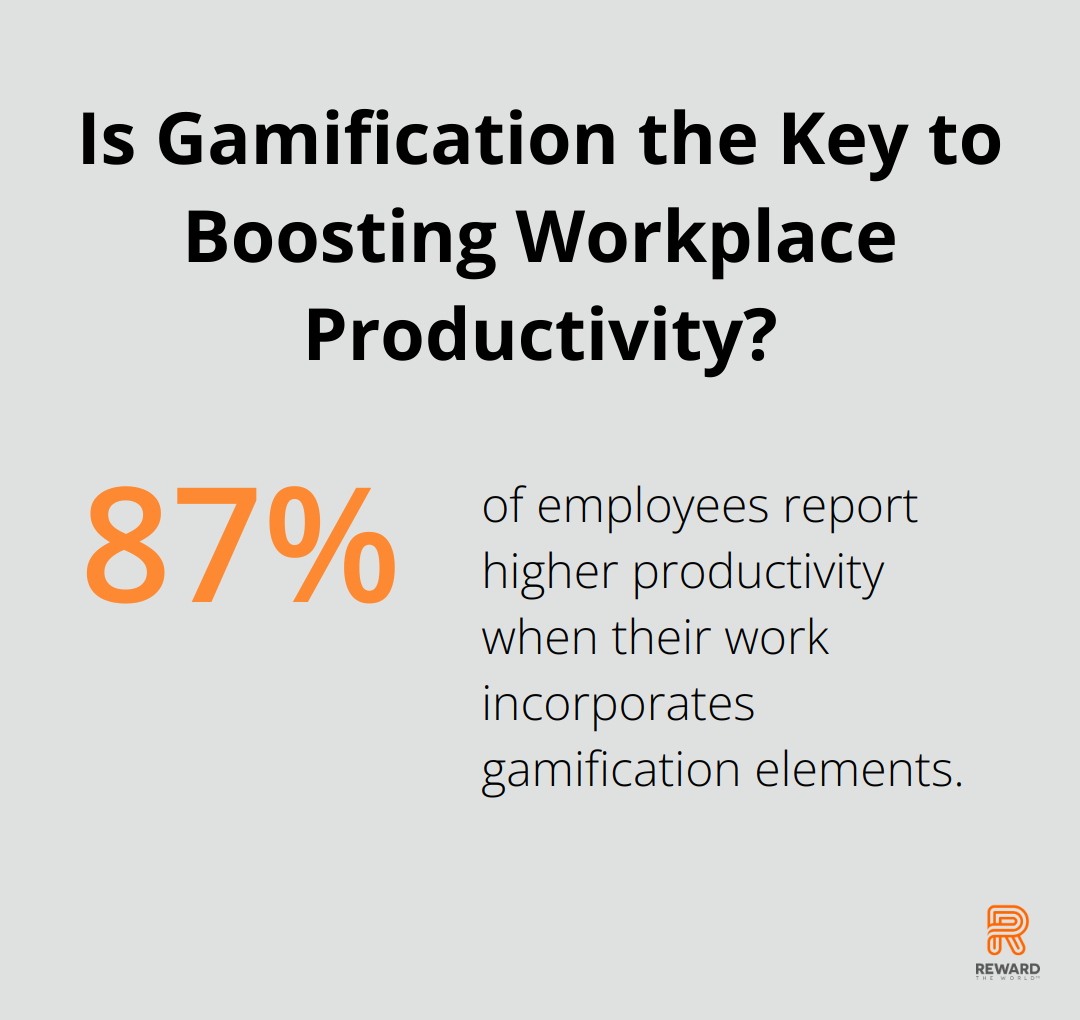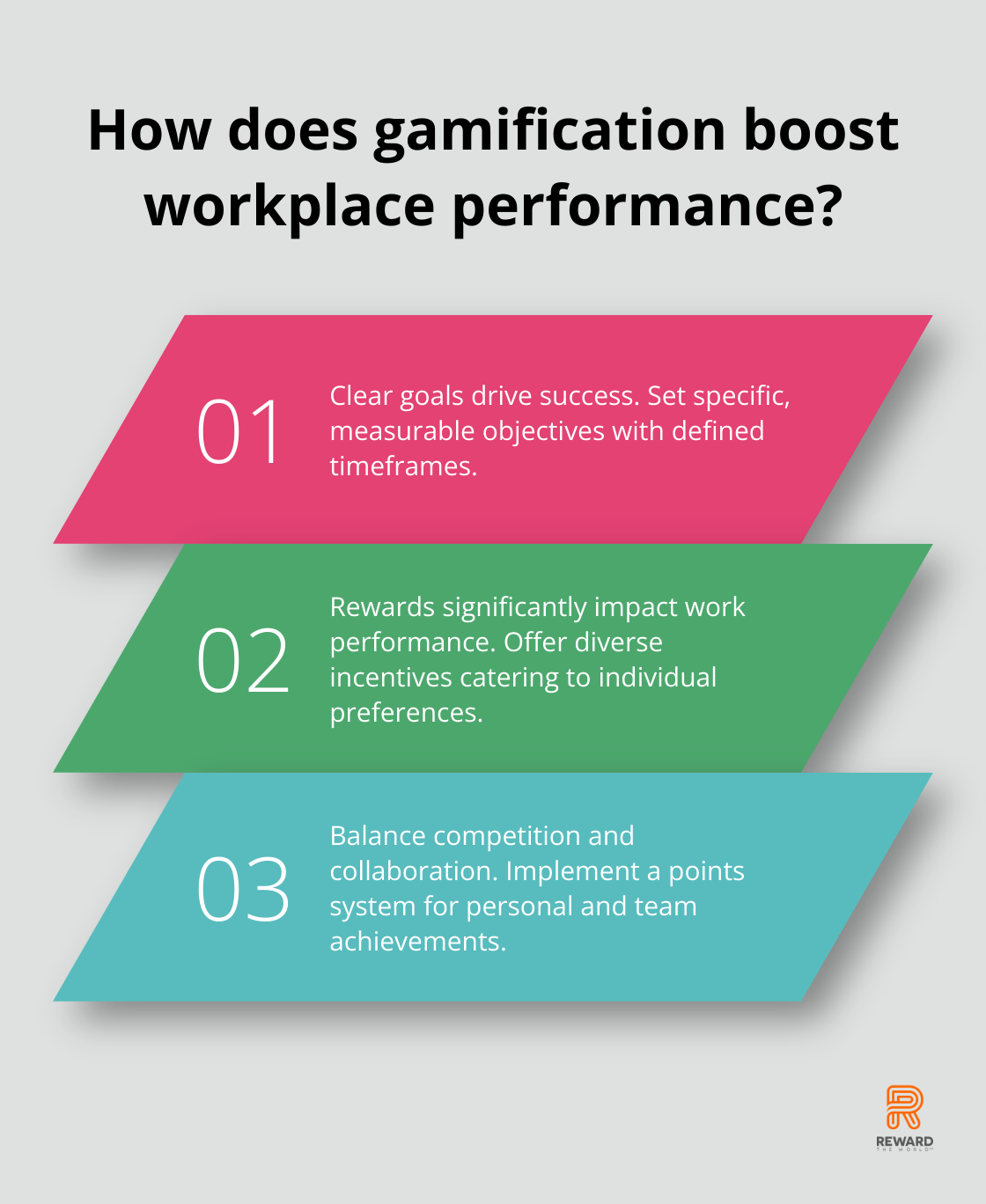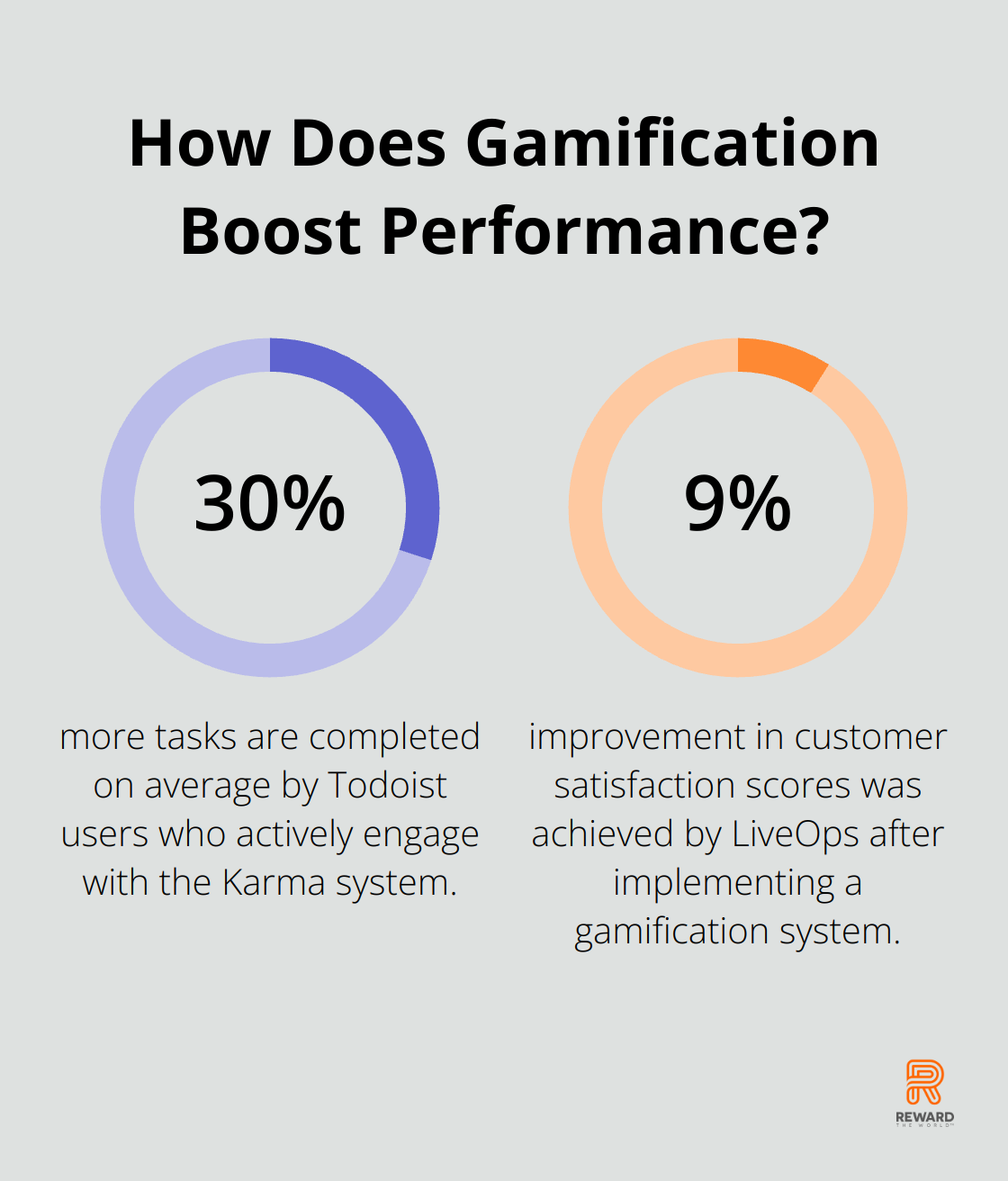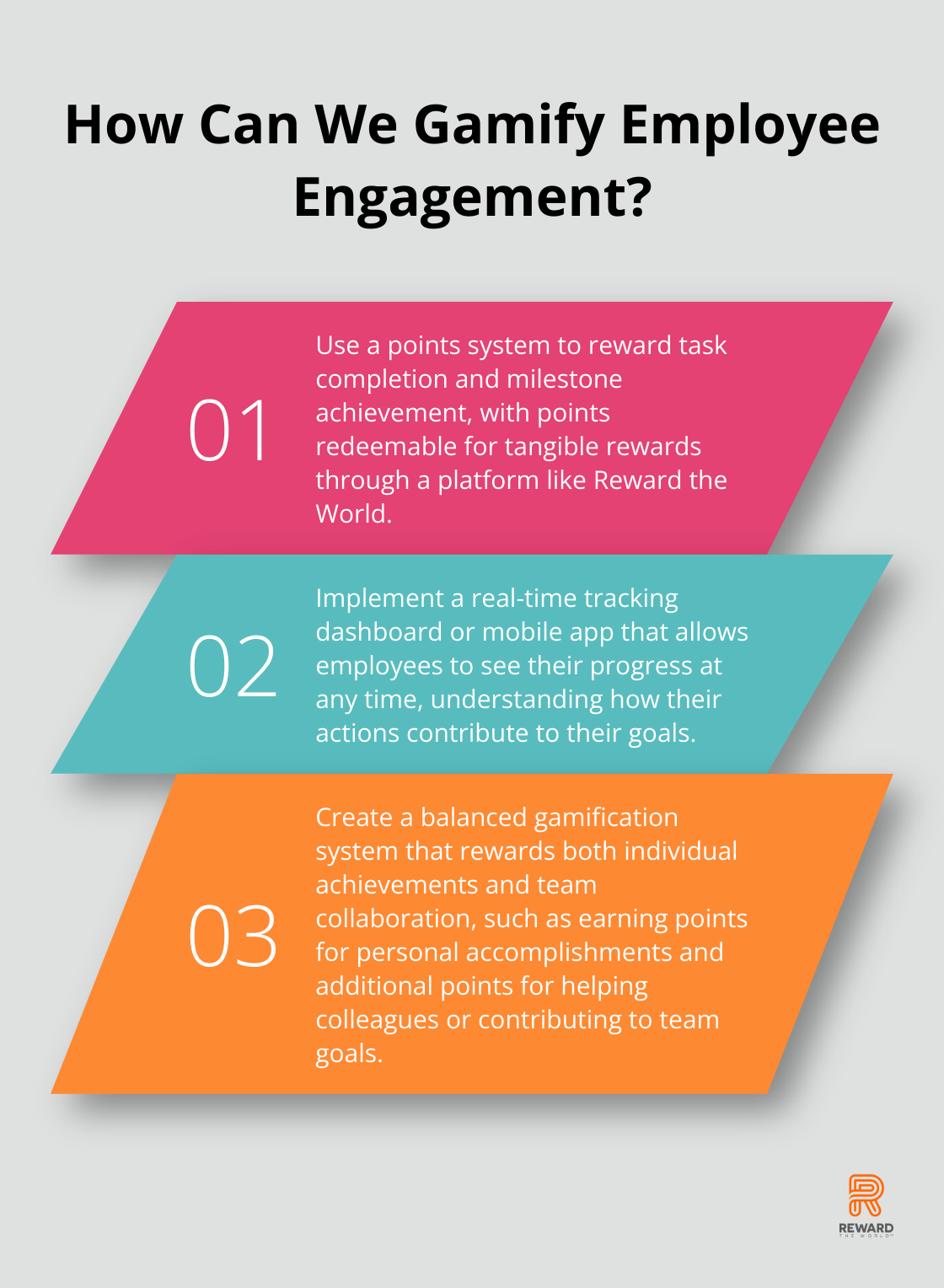
Workplace gamification is revolutionizing how companies engage their employees. At Reward the World, we’ve seen firsthand how this innovative approach can transform productivity and job satisfaction.
The benefits of gamification in the workplace are numerous, from boosting motivation to fostering healthy competition. In this post, we’ll explore effective strategies and real-world examples to help you implement gamification successfully in your organization.
What Is Workplace Gamification?
Defining Workplace Gamification
Workplace gamification applies game-like elements to non-game contexts in professional environments. This approach transforms routine tasks into engaging experiences, which boosts employee motivation and productivity.
The Science Behind Gamification
Gamification taps into our brain’s reward system. Task completion or goal achievement in a gamified system triggers dopamine release, a feel-good neurotransmitter. This creates a positive feedback loop, encouraging behavior repetition. A TalentLMS study found that 87% of employees report higher productivity when their work incorporates gamification elements.
Key Elements of Workplace Gamification
Effective workplace gamification typically includes:
- Points: These reward task completion or milestone achievement.
- Leaderboards: They display top performers to encourage healthy competition.
- Badges: These serve as visual representations of achievements.
- Levels: They indicate progress and unlock new challenges.
- Rewards: These offer tangible or intangible incentives for reaching goals.
Boosting Engagement and Productivity
Gamification significantly impacts employee engagement and productivity. A Gallup study revealed that highly engaged teams show greater profitability. Game elements make work more enjoyable and motivating.

For example, a sales team might use a leaderboard to track monthly performance. This provides clear goals and taps into natural competitive spirit. Combined with rewards for top performers, this can drive substantial improvements in sales figures.
Implementing Gamification Effectively
To maximize gamification benefits, align game elements with your company’s goals and culture. A one-size-fits-all approach won’t suffice. Instead, tailor your gamification strategy to your specific needs and workforce.
For instance, if you aim to improve customer service, you might implement a points system for positive customer feedback. Employees could then redeem these points for rewards through a platform like Reward the World, which offers a vast array of incentives to suit diverse preferences.
The key to successful gamification lies in balance. While competition motivates, it shouldn’t create a stressful or divisive environment. Focus on personal improvement and team collaboration alongside individual achievements.
As we move forward, let’s explore effective strategies to implement gamification in your workplace, ensuring it aligns with your organizational goals and culture.
How to Implement Effective Gamification Strategies
Implementing gamification in the workplace requires a thoughtful approach that aligns with your company’s goals and culture. Here are some strategies to make your gamification efforts more effective:
Set Clear, Achievable Goals
The foundation of any successful gamification strategy is to set clear, measurable objectives. These goals should challenge employees to stretch their abilities without overwhelming them. For example, a call center might set a goal to reduce average call handling time by 10% over three months. This goal is specific, measurable, and has a clear timeframe.
Design Meaningful Rewards
Rewards play a key role in gamification, but they must resonate with your employees. Studies have found that rewards and recognition significantly correlate with work performance. This underscores the importance of offering a diverse range of incentives that cater to individual preferences.
Balance Competition and Collaboration
While competition can motivate, it’s essential to strike a balance to avoid creating a cutthroat environment. Encourage both individual achievement and team collaboration. You could implement a points system where employees earn points for personal accomplishments and additional points for helping colleagues or contributing to team goals. This approach fosters a supportive work culture while still tapping into the motivational power of competition.
Implement Real-Time Tracking and Feedback
Real-time tracking and feedback maintain engagement in your gamification system. Employees should see their progress at any time, understanding how their actions contribute to their goals. Many companies use dashboards or mobile apps to provide this visibility. AI enhances real-time feedback in gamification, driving engagement and success.
Continuously Refine Your Strategy
The key to successful gamification is continuous refinement. Gather feedback from your employees regularly and analyze the data to understand what works and what doesn’t. This iterative approach will help you create a gamification strategy that truly resonates with your team and drives the results you’re aiming for. Gamification can be used to increase workplace learning and employee engagement, not just in formal learning contexts, but also systematically in informal learning settings.

As we move forward, let’s explore some real-world examples of successful workplace gamification to inspire your own implementation.
Real-World Gamification Success Stories
Sales Team Motivation at Xerox
Xerox, the printing and digital document solutions giant, faced a challenge in motivating its sales team. They introduced a gamified system called Qstream, which transformed product training into a competitive, game-like experience. Xerox also provided internal and external incentives as well as equitable rewards to motivate different employees based on their individual needs and perspectives. These efforts helped improve employee engagement and performance.
Onboarding Revolution at Deloitte
Deloitte transformed its onboarding process with a gamified program called Deloitte Leadership Academy. New hires progressed through levels, earned badges, and competed on leaderboards as they completed training modules. Deloitte’s story is a compelling example of gamification’s potential to transform learning initiatives. They tracked user engagement, completion rates, and other relevant metrics to assess the effectiveness of their gamified learning approach.
Productivity Boost with Todoist Karma
Todoist, a popular task management app, incorporates gamification through its Karma system. Users earn points for completing tasks and maintaining productive streaks. This simple yet effective approach has helped millions of users stay motivated and productive. According to Todoist, users who actively engage with the Karma system complete 30% more tasks on average than those who don’t.
Problem-Solving at Google
Google’s famous “20% time” policy (where employees could spend one day a week on side projects) was essentially a gamified approach to innovation. This led to the creation of Gmail and Google News, among other successful products. While the formal policy has evolved, the spirit of rewarding creative problem-solving remains a core part of Google’s culture.
Customer Service Excellence at LiveOps
LiveOps, a virtual call center company, implemented a gamification system for their remote workforce. Agents earned points, badges, and status for completing training and achieving performance targets. This approach resulted in a 15% reduction in call times and a 9% improvement in customer satisfaction scores.

These success stories demonstrate the power of gamification when implemented thoughtfully. The key lies in designing systems with specific goals in mind and aligning them with company culture. Try to apply these lessons to create a successful gamification strategy in your own organization (keeping in mind your unique needs and workforce dynamics).
Final Thoughts
Workplace gamification transforms mundane tasks into exciting challenges, fostering a dynamic and motivated workforce. The benefits of gamification in the workplace include increased productivity, improved learning outcomes, and higher employee retention rates. These advantages stem from tapping into our innate desire for achievement and recognition, creating a positive feedback loop that drives continuous improvement.

Successful implementation of gamification requires alignment with organizational goals and culture. Organizations must set clear objectives, design meaningful rewards, and balance competition with collaboration. Real-time feedback keeps employees engaged and motivated, while technology advancements promise more sophisticated and personalized gamification systems in the future.
Reward the World offers comprehensive solutions for organizations looking to implement or enhance their gamification strategies. With its array of instant rewards and integration capabilities, Reward the World can help create a gamification system that resonates with your workforce. Embracing these innovative approaches will shape the future of work, creating more engaging and fulfilling work environments.
